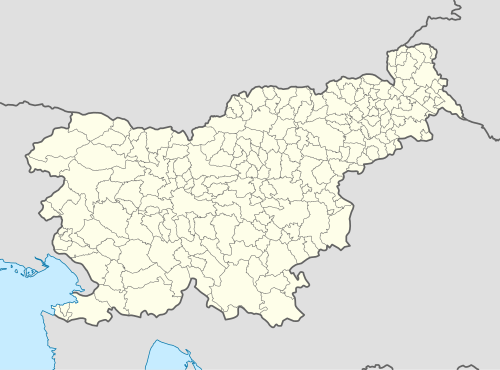Zlateče pri Šentjurju
| Zlateče pri Šentjurju Sveta Rozalija (until 1953) | |
|---|---|
 Zlateče pri Šentjurju Location in Slovenia | |
| Coordinates: 46°13′46.15″N 15°21′43.09″E / 46.2294861°N 15.3619694°ECoordinates: 46°13′46.15″N 15°21′43.09″E / 46.2294861°N 15.3619694°E | |
| Country |
|
| Traditional region | Styria |
| Statistical region | Savinja |
| Municipality | Šentjur |
| Area | |
| • Total | 1.65 km2 (0.64 sq mi) |
| Elevation | 324.4 m (1,064.3 ft) |
| Population (2002) | |
| • Total | 107 |
| [1] | |
Zlateče pri Šentjurju (pronounced [zlaˈteːtʃɛ pɾi ʃɛnˈtjuːɾju] or [zlaˈteːtʃɛ pɾi ʃənˈtjuːɾju]) is a settlement in the Municipality of Šentjur in eastern Slovenia. The area is part of the historical region of Styria and is included in the Savinja Statistical Region.[2]
Name
The name of the settlement was changed from Sveta Rozalija (literally, 'Saint Rosalia') to Zlateče pri Šentjurju in 1953. The name was changed on the basis of the 1948 Law on Names of Settlements and Designations of Squares, Streets, and Buildings as part of efforts by Slovenia's postwar communist government to remove religious elements from toponyms.[3][4][5]
Church
The local church, built on a hill east of the settlement, is dedicated to Saint Rosalia and belongs to the Parish of Šentjur. It dates to the 17th century with a chapel dedicated to Saint Anthony added to the south part of the nave in the 1746.[6] The church was built as a response to the plague of 1645–1660. The church is distinguished by its high-quality architecture and stonework. The main altar dates from 1667, and the three altars in the nave from 1859. The chancel was painted in 1908 by the Celje painter Albin Paradiž (?–1910). The glass chandelier dates to 1850. The largest of the church's bells was cast in Celje in 1756 by Gašper Schneider (1726–1774); its tone was considered so strikingly gentle that the composer Gustav Ipavec composed the song "Iz stolpa sem mi zvon doni" (The Bell Rings to Me from the Tower) in its honor. Saint Anthony's chapel contains frescoes by the Ljubljana painter Franc Jelovšek (1700–1764), an altar dating from 1864–1866 by the Celje wood-carver Ignacij Oblak (1834–1916), and a pulpit from 1870.[7]
References
- ↑ Statistical Office of the Republic of Slovenia Archived November 18, 2008, at the Wayback Machine.
- ↑ Šentjur municipal site
- ↑ Spremembe naselij 1948–95. 1996. Database. Ljubljana: Geografski inštitut ZRC SAZU, DZS.
- ↑ Premk, F. 2004. Slovenska versko-krščanska terminologija v zemljepisnih imenih in spremembe za čas 1921–1967/68. Besedoslovne lastnosti slovenskega jezika: slovenska zemljepisna imena. Ljubljana: Slavistično društvo Slovenije, pp. 113–132.
- ↑ Urbanc, Mimi, & Matej Gabrovec. 2005. Krajevna imena: poligon za dokazovanje moči in odraz lokalne identitete. Geografski vestnik 77(2): 25–43.
- ↑ Slovenian Ministry of Culture register of national heritage Archived July 12, 2010, at the Wayback Machine. reference number ešd 3045
- ↑ Savnik, Roman, ed. 1976. Krajevni leksikon Slovenije, vol. 3. Ljubljana: Državna založba Slovenije, p. 349.
